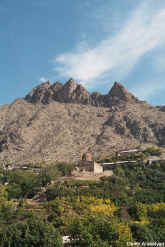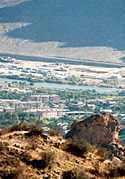|

|
The city of
Meghri
hoasts a dilapidated hotel, lots of places for thirsty truckers
to buy vodka for the road, and amazing lush fruits and vegetables. The figs are particularly famous. The setting is striking, with green gardens in the rocky desert. There is a fortress
on the hillson
the N and E of city, known
from the 10th
century but rebuilt in the
|
|
Between Karchevan and
Agarak
(founded
1949) the dirt road passes along the edge of a huge open-pit
copper-molybdenum mine. From Agarak,
the road descends to the Iranian border. The border-crossing bridge
and new customs point
is nearby, with long
lines of trucks generally waiting for some
mysterious paperwork to
arrive from somewhere.
|

|
|
early
18th c. by Davit Bek. It had four 2-story circular towers and two rectangular, but
no circuit wall between them. This
was the only Armenian fortress specifically designed for firearms. In 1727, 400 of Davit Bek’s men held off
many times their
number of Turkish troops for 5 days, till relief troops arrived.
In the Mets Tagh district below the fortress is a 17th
c. Astvatsatsin church with interesting 19th c. wall
paintings. In the Pokr Tagh
district SW is a 17th c. S.
Sargis basilica church, with battered 17th c.
frescoes. Also in the SW
part of town up the slope is Meghru Vank with a S.
Hovhannes church (15-17th c.). From the roof there is an excellent view of the entire district. This area has crumbling remains of 18-19th c.
houses.
Another remains of ruined 19th
century
church
is on the eastern side of the city, just left from the road
directing to the fortress.
|
|
In
the former village of Agarak close by are two 17th c. churches,
Aknakhach and S. Amenaprkich
Vank. The scenery
along the Arax river is striking, jagged, arid gorges juxtaposed with verdant river valleys. |